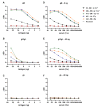Elephant Endotheliotropic Herpesvirus Is Omnipresent in Elephants in European Zoos and an Asian Elephant Range Country
- PMID: 33670367
- PMCID: PMC7917619
- DOI: 10.3390/v13020283
Elephant Endotheliotropic Herpesvirus Is Omnipresent in Elephants in European Zoos and an Asian Elephant Range Country
Abstract
Elephant endotheliotropic herpesviruses (EEHVs) may cause acute, often lethal, hemorrhagic disease (EEHV-HD) in young elephants. Prevalence of EEHV in different elephant populations is still largely unknown. In order to improve diagnostic tools for the detection of EEHV infections and to obtain insight into its spread among elephants, we developed novel ELISAs based on EEHV1A gB and gH/gL. Performance of the ELISAs was assessed using sera from 41 European zoo elephants and 69 semi-captive elephants from Laos, one of the Asian elephant range countries. Sera from all (sub)adult animals tested (≥5 years of age) showed high reactivity with both gB and gH/gL, indicating that EEHV prevalence has been highly underestimated so far. Reactivity towards the antigens was generally lower for sera of juvenile animals (1 > 5 years). Only one (juvenile) animal, which was sampled directly after succumbing to EEHV-HD, was found to be seronegative for EEHV. The two other EEHV-HD cases tested showed low antibody levels, suggesting that all three cases died upon a primary EEHV infection. In conclusion, our study suggests that essentially all (semi-)captive (sub)adult elephants in European zoos and in Laos carry EEHV, and that young elephants with low antibody levels are at risk of dying from EEHV-HD.
Keywords: EEHV; elephant; gB; gH/gL; herpesviruses; immunoserology.
Conflict of interest statement
The authors declare no conflict of interest. Funders had no role in the study design, data collection and analysis, decision to publish, or preparation of the manuscript.
Figures






References
-
- Howard L., Schaftenaar W. Fowler’s Zoo and Wild Animal Medicine Current Therapy. Vol. 9 Elsevier; Saunders, PA, USA: 2018. Elephant Endotheliotropic Herpesvirus.
-
- Jeffrey A., Evans T.S., Molter C., Howard L.L., Ling P., Goldstein T., Gilardi K. Noninvasive sampling for detection of elephant endotheliotropic herpesvirus and genomic DNA in Asian (Elephas maximus) and African (Loxodonta africana) elephants. J. Zoo Wildl. Med. 2020;51:433–437. doi: 10.1638/2019-0112. - DOI - PMC - PubMed
-
- Boonprasert K., Punyapornwithaya V., Tankaew P., Angkawanish T., Sriphiboon S., Titharam C., Brown J.L., Somgird C. Survival analysis of confirmed elephant endotheliotropic herpes virus cases in Thailand from 2006–2018. PLoS ONE. 2019;14:e0219288. doi: 10.1371/journal.pone.0219288. - DOI - PMC - PubMed
Publication types
MeSH terms
Substances
LinkOut - more resources
Full Text Sources
Other Literature Sources

